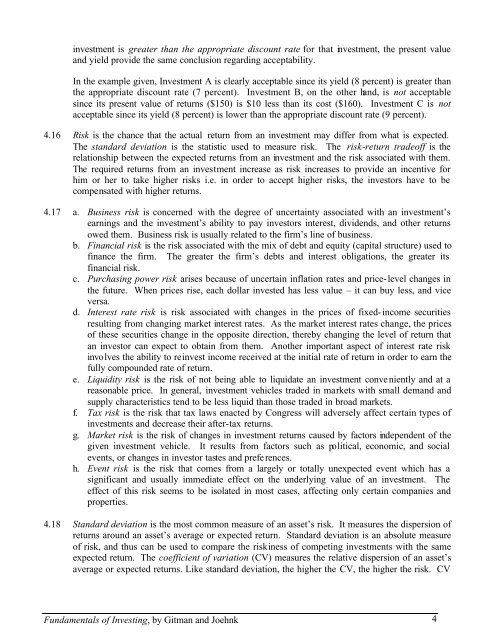CHAPTER 4: ANSWERS TO CONCEPTS IN REVIEW
CHAPTER 4: ANSWERS TO CONCEPTS IN REVIEW
CHAPTER 4: ANSWERS TO CONCEPTS IN REVIEW
You also want an ePaper? Increase the reach of your titles
YUMPU automatically turns print PDFs into web optimized ePapers that Google loves.
investment is greater than the appropriate discount rate for that investment, the present value<br />
and yield provide the same conclusion regarding acceptability.<br />
In the example given, Investment A is clearly acceptable since its yield (8 percent) is greater than<br />
the appropriate discount rate (7 percent). Investment B, on the other hand, is not acceptable<br />
since its present value of returns ($150) is $10 less than its cost ($160). Investment C is not<br />
acceptable since its yield (8 percent) is lower than the appropriate discount rate (9 percent).<br />
4.16 Risk is the chance that the actual return from an investment may differ from what is expected.<br />
The standard deviation is the statistic used to measure risk. The risk-return tradeoff is the<br />
relationship between the expected returns from an investment and the risk associated with them.<br />
The required returns from an investment increase as risk increases to provide an incentive for<br />
him or her to take higher risks i.e. in order to accept higher risks, the investors have to be<br />
compensated with higher returns.<br />
4.17 a. Business risk is concerned with the degree of uncertainty associated with an investment’s<br />
earnings and the investment’s ability to pay investors interest, dividends, and other returns<br />
owed them. Business risk is usually related to the firm’s line of business.<br />
b. Financial risk is the risk associated with the mix of debt and equity (capital structure) used to<br />
finance the firm. The greater the firm’s debts and interest obligations, the greater its<br />
financial risk.<br />
c. Purchasing power risk arises because of uncertain inflation rates and price-level changes in<br />
the future. When prices rise, each dollar invested has less value – it can buy less, and vice<br />
versa.<br />
d. Interest rate risk is risk associated with changes in the prices of fixed-income securities<br />
resulting from changing market interest rates. As the market interest rates change, the prices<br />
of these securities change in the opposite direction, thereby changing the level of return that<br />
an investor can expect to obtain from them. Another important aspect of interest rate risk<br />
involves the ability to reinvest income received at the initial rate of return in order to earn the<br />
fully compounded rate of return.<br />
e. Liquidity risk is the risk of not being able to liquidate an investment conveniently and at a<br />
reasonable price. In general, investment vehicles traded in markets with small demand and<br />
supply characteristics tend to be less liquid than those traded in broad markets.<br />
f. Tax risk is the risk that tax laws enacted by Congress will adversely affect certain types of<br />
investments and decrease their after-tax returns.<br />
g. Market risk is the risk of changes in investment returns caused by factors independent of the<br />
given investment vehicle. It results from factors such as political, economic, and social<br />
events, or changes in investor tastes and preferences.<br />
h. Event risk is the risk that comes from a largely or totally unexpected event which has a<br />
significant and usually immediate effect on the underlying value of an investment. The<br />
effect of this risk seems to be isolated in most cases, affecting only certain companies and<br />
properties.<br />
4.18 Standard deviation is the most common measure of an asset’s risk. It measures the dispersion of<br />
returns around an asset’s average or expected return. Standard deviation is an absolute measure<br />
of risk, and thus can be used to compare the riskiness of competing investments with the same<br />
expected return. The coefficient of variation (CV) measures the relative dispersion of an asset’s<br />
average or expected returns. Like standard deviation, the higher the CV, the higher the risk. CV<br />
Fundamentals of Investing, by Gitman and Joehnk<br />
4
















